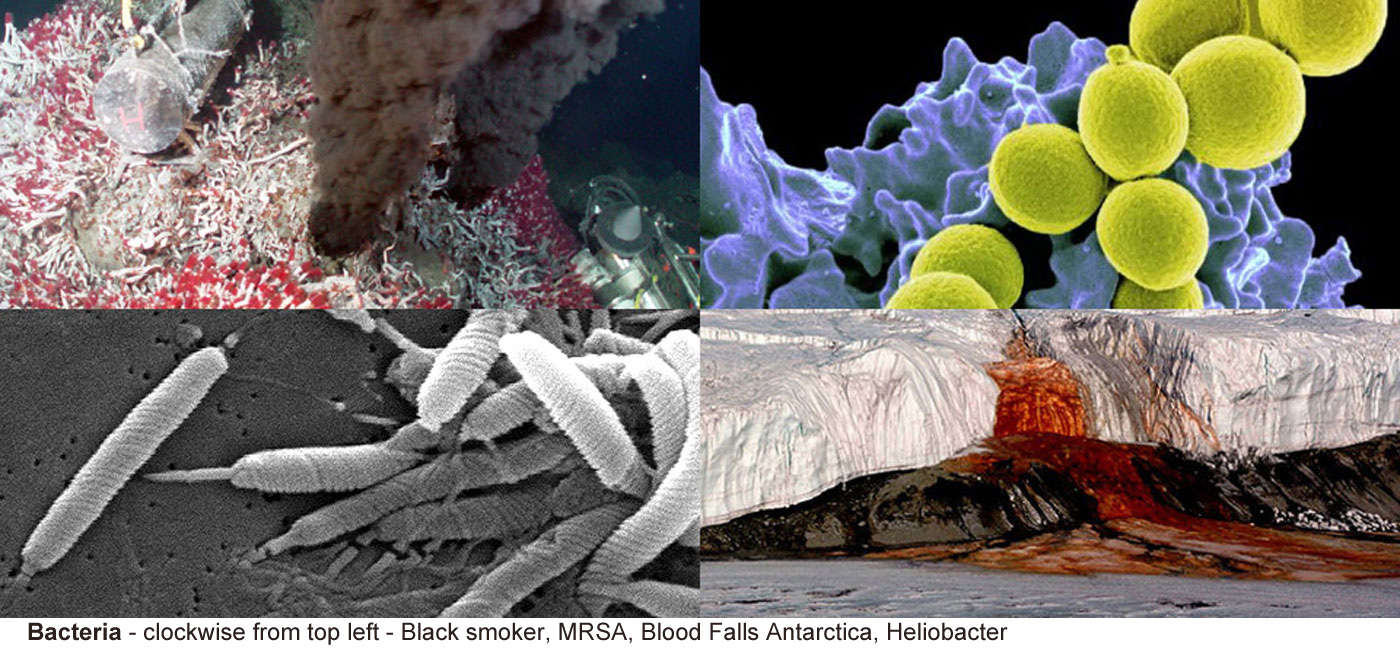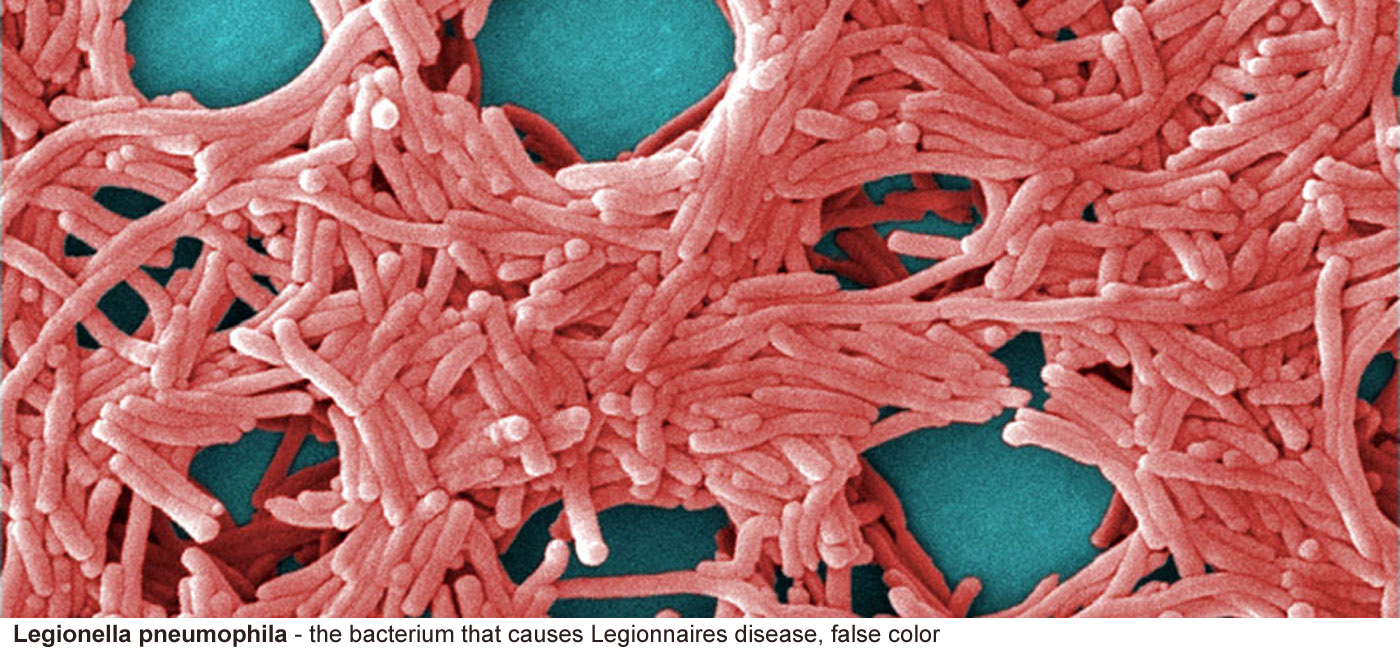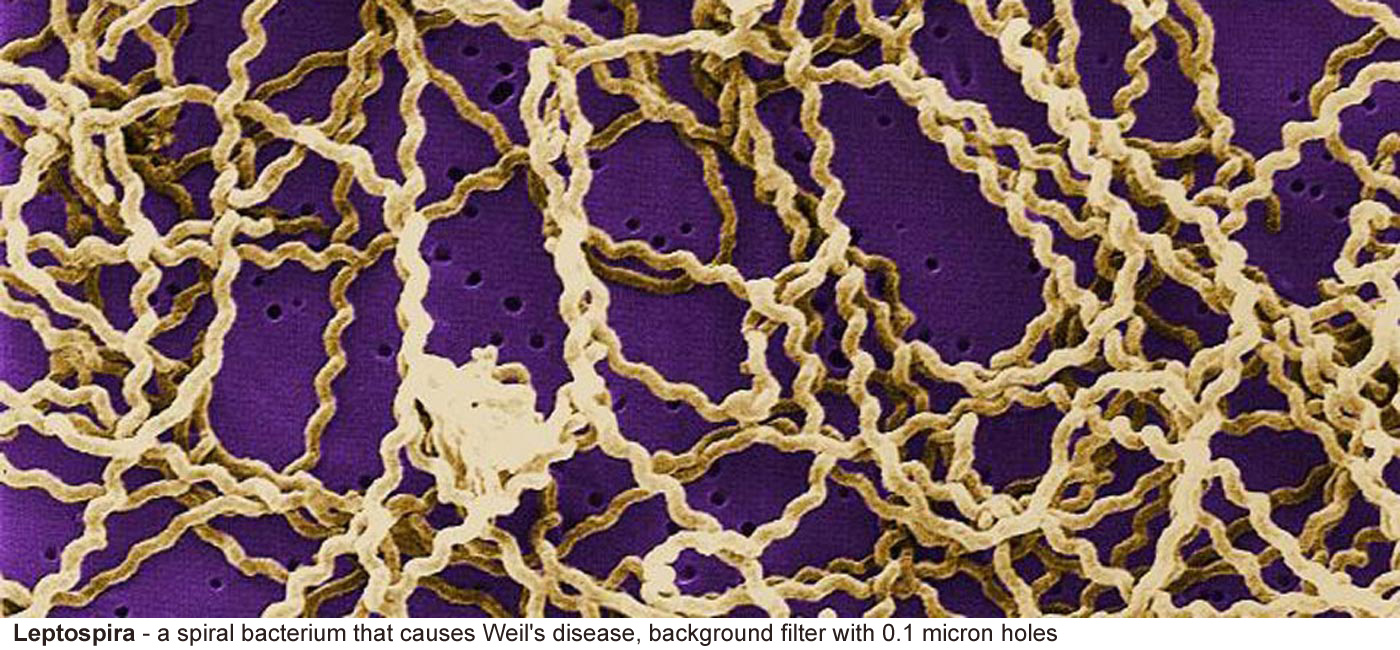Bacteria - Prokaryotes
The
oldest life forms, and the most widespread
 Vibrio vulnificus, a bacterium that lives in marine
Vibrio vulnificus, a bacterium that lives in marineenvironments, though can cause disease if it
enters the body via a wound or food. False color.
The Domain Bacteria is a higher level group quite separate from plants and animals. They are the most primitive group of organisms, which doesn't mean that they are less evolved than others, just that organisms very like them arose a very long time ago that were also bacteria. In this sense "primitive" in biological terms is like saying someone comes from a "very old family, with a long family tree". Organisms like bacteria were the first living organisms to evolve on earth.
Studying bacteria is difficult as they are all microscopic, quite often with one dimension being around 1 micron (a micron or micrometer is a millionth of a meter). Most of your cells are around 10-20 microns in size, so bacteria are small cells. They also look very similar to each other. Some are spheres, some are rods of various lengths, some are spirals of various lengths, and they may or may not have a flagellum (tail) that they use to swim with, and some have a slime capsule around them, but that's about it in terms of variety of form.
When you grow them on an agar plate, they can be different colors, though not a huge range, cream, through yellow to orange and red are about it, and a huge number of them are shades of off-white. Bacteria grow by division when they get big enough to be two bacteria, by the time they are visible on an agar plate or some food you forgot about in the fridge, there are millions of them.
Prokaryotes
Bacteria are prokaryotes, pro - before, karyos - nucleus. Their defining characteristic is that they don't have a nucleus, it is often considered to be the most important distinction amongst living organisms. The DNA is in a large loop in the cytoplasm rather than being contained within a membrane-bound nucleus. There are also other significant differences between pro and eukaryotes (eukaryotes are organisms that do have a membrane bound nucleus). It is thought that the eukaryotes may have arisen from a process called endosymbiosis whereby prokaryote cells were taken into another prokaryotic cell, some of the organelles of eukaryotic cells are very similar to prokaryotes themselves, particularly mitochondria and chloroplasts.
Differences between bacteria
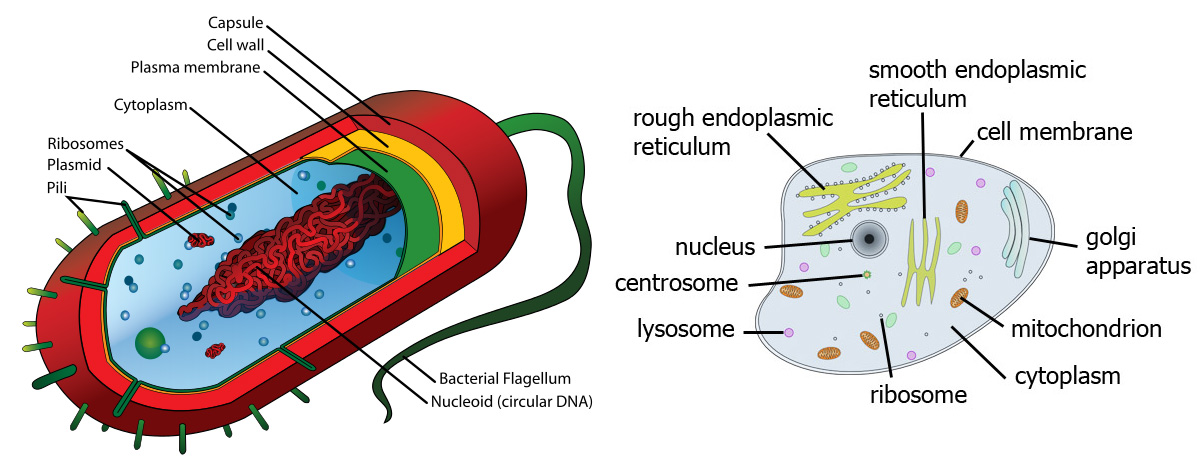
A prokaryotic bacterium on the left compared
to a eukaryotic animal cell on the right.
The bacterium
is about the same size as the mitochondrion in the animal cell.
Despite the appearances not giving much away, there are an enormous number of bacterial species and they can behave and live in very different ways. One way of looking at it is to imagine a load of books in a library all being the same size(ish) and having the same cream cover. Once you get inside the book though, you find some are romance novels, some thrillers, some are on car maintenance etc. etc., well bacteria are like that (except for the book bit and as yet, none have displayed evidence of romanticism).
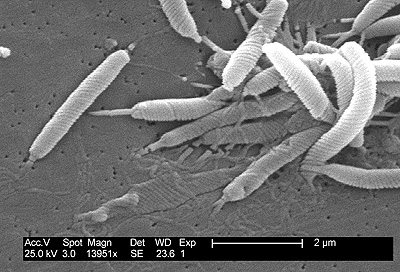 Heliobacter, a bacterium with a characteristic helical
Heliobacter, a bacterium with a characteristic helical(spiral) pattern, they can move quickly with their
flagella, and can cause stomach ulcers in humans
Bacteria live everywhere, really everywhere. There are bacteria inside you and others living on you. The average human is made of about 6 trillion cells and carries around with them more than 6 trillion bacteria. There will bacteria on the screen you are reading this on (though they'll probably be dormant unless you regularly do the "just spat coffee on my screen" thing) and also on the keyboard or mouse you're using.
There are bacteria in the gut of all living things, the soil is full of them, there is a bacterial "snow" in the air around us, they live on rocks, in rocks, and even deep underground. Wherever there is any other kind of life, you will find bacteria, you will also find bacteria in places where nothing else can live.
As you can't see bacteria unless they are in a massive group, and even when you can see them, they all look like a few basic types anyway, classifying them is very difficult. So instead I'm going to discuss some of the more important and interesting ones.
Disease Causing Bacteria (pathogenic bacteria - pathogens)
 MRSA (yellow) and a white blood cell (blue)
MRSA (yellow) and a white blood cell (blue) false colour image
We all know that many bacteria are "bad" in that they can make us ill and cause disease, including some well known ones such as Tuberculosis (TB), Diphtheria, Meningitis, Leprosy, Tetanus, the Black Death and Syphilis, all of which it's really best to avoid.
There are relatively few bacteria that are human pathogens, and even then some of them have another string to their bow. For instance, Clostridium tetani, the bacterium that causes tetanus in humans exists without causing problems in the gut of some animals, such as horses, sheep and dogs. However if the spores that are passed out onto the soil then get into an open wound, the bacterium becomes pathogenic and potentially fatal, it is an opportunist (facultative) rather than an obligate (obliged to be, it all seems terribly polite) pathogen.
Until the 1940's when penicillin, the first antibiotic, was first isolated in quantities it was possible to contract a fatal bacterial infection by relatively simple means. If you had lived in the 1800's for instance, you would almost certainly known of someone who had died of toothache. Yes toothache! Actually, not really just toothache, but an infection that arose from a toothache resulting from poorer dental hygiene and then the inability to be able to do anything meaningful about that infection. It was one of the reasons that people sometimes used to get all of their teeth removed as a preventative measure when they became adult.
Starting with penicillin, we now have a whole range of antibiotics that are actually able to kill pathogenic bacteria that are making us ill. One reason for the reduction in deaths in World War 2 compared to World War 1 is that antibiotics were available for WW2 that weren't available earlier. Deaths from infections arising from non-fatal injuries used to be quite a regular occurance before the discovery of antibiotics.
The Bacteria Fight Back
You may have heard of "Superbugs" such as MRSA which stands for (deep breath) Methicillin Resistant Staphylococcus Aureus. It means that the bacterium is resistant to methicillin, a powerful antibiotic, the bacterium is staphylo - clustered, coccus - spherical and aureus - golden. So it is a spherical bacterium that gathers in clumps and is golden. MRSA is resistant to many antibiotics. It's not likely to cause any great epidemic however as it tends to only be dangerous to people who have already weakened immune systems. In itself it is not a particular aggressive pathogen, its danger comes from it being a difficult to treat secondary infection in people who are already ill and often in hospital with some other ailment that is stressing their immune system. It can and does kill many people each year who otherwise would have recovered from their original illness.
There are other bacteria that are also becoming resistant to the antibiotics we already have, this will become an increasing problem as time goes on, as new antibiotics are expensive to develop and drug companies aren't keen on them as they don't make much profit.
Useful Bacteria
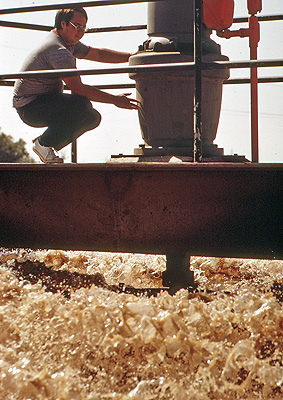 Mixing of incoming sewage with bacteria
Mixing of incoming sewage with bacteriawhich will bring about the
decomposition of the sewage
One of the most useful things that bacteria do for us is to treat and digest sewage. Yes I know it's not nice to think about, but all over the world are sewage works which take in the stuff that is flushed down drains and turns it into something significantly less polluting. These sewage works are basically large bacterial cultures, they make conditions ideal for helpful bacteria by lots of churning and aeration which enables them to break down the sewage and also does away with harmful bacteria which usually like anaerobic (without oxygen) conditions. When the bacteria have done their job, what is left is a liquid which can be released into rivers and a sludge (very smelly sludge admittedly) that makes good agricultural fertilizer.
Bacteria are responsible for the digestion of cellulose in many of the world's herbivorous animals such as cattle, sheep, goats, deer, kangaroos, elephants and rabbits. The bacteria live in the gut of these animals and allows them to get access to the energy in the cellulose that is otherwise unavailable to them as they lack the required cellulase digestive enzyme.
If there was no decomposition we would be wading around in dead things and faeces. Bacteria along with fungi are the planets great recyclers. Each autumn (or fall if you prefer) there are piles of leaves all over the place, by the end of winter and certainly by the spring they are no-where to be seen. They have been used by bacteria and fungi for food and used up in the process. Even other organisms that we think of as decomposers such as earthworms eat partly decayed leaves to strip the bacteria from them rather than being able to decompose the leaves directly themselves. All an ecosystem needs to work is producers and decomposers, the herbivores, and various levels of carnivores are all optional.
What do Bacteria Eat?
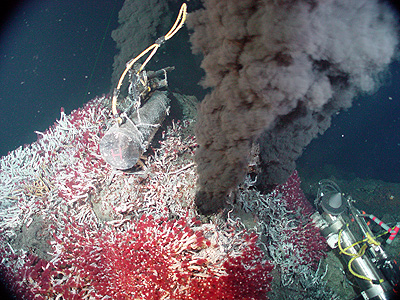 A "black smoker" an undersea hydrothermal vent,
A "black smoker" an undersea hydrothermal vent,spewing out metallic sulfides, red tube worms can
be seen which harbor chemoautotroph bacteria
They don't eat in the way that we think of eating by taking large food particles into their body and digesting them. They absorb food molecules directly (those that live in the digestive tracts of animals for instance) or they use external digestion where they secrete enzymes onto food which then breaks it down and the products are then absorbed. This external digestion is what makes food go "off" when bacteria (and/or fungi) move in and start to digest it.
Some bacteria get their energy by living in and around hot water springs and vents where there are high levels of dissolved chemicals, they take the chemicals and perform a reaction with them which releases energy which is used in a similar manner to the energy derived from more conventional food. Such a process is called chemosynthesis and is similar to photosynthesis, though the whole system is powered far from the light of the sun. At the surface, such springs can have bright colored mats of bacteria growing around them at temperatures that other organisms cannot withstand.
Other such vents are found in the pitch black of the deep oceans (average depth 2100m), very hot water at temperatures that can be over 400C black with dissolved minerals spout out as "black smokers". The warm temperatures (it quickly gets cooler away from the vent) and high mineral concentrations mean that bacteria can live there as the basis of the food chain. Such vents can have large rich isolated ecosystems of organisms around them.
 Blood Falls Antarctica, the outlet of a hidden lake
Blood Falls Antarctica, the outlet of a hidden lakeunder a glacier, rich in iron or possibly sulfate
feeding bacteria. The color is from iron, not the
bacteria itself.
Other bacteria can live in mineral deposits in mines or from mineral rich rocks. An example is of bacteria that take iron II ions and turn them into iron III ions producing a rich brown discharge in the process which may be mistaken for a bacterial mat but is actually iron oxide that can appear as a gelatinous slime. These bacteria can live in a domestic water supply if there is a high content to the water and lead to stained clothing and fixtures.
Other chemosynthetic bacteria may use manganese, arsenic, uranium or sulfides in a similar manner.
That bacteria have been discovered living in extreme heat or cold, deep in the earth and in environments where the levels of dissolved substances would be toxic to other organisms has led to these types being known as "Extremophiles" extreme-lovers. Such extreme conditions probably exist in other parts of the solar system leading to speculation that the conditions needed to support life are not as limited as previously thought. Prokaryotic-like life forms may be found in places such as some moons of Jupiter, Saturn or Neptune where there are definite or suspected large bodies of water with similar conditions to where extremeophiles on earth live.
Remote probes to other bodies in the solar system now usually have some instrumentation to test for signs of microscopic life they might come across. It is thought that ET is far more likely to be an extremeophile microbe than a little green man.

